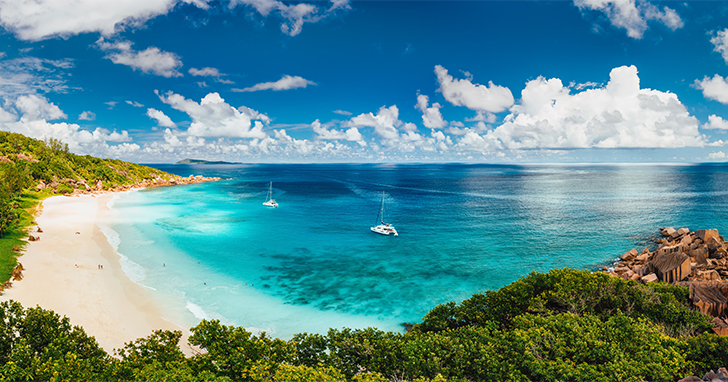
Fish From Around the World: Spotlight the AfricaAre most African fish caught or captive bred?
Africa is the second largest continent in the world. As such, there are a variety of regions in which aquatic life lives. Species that thrive in freshwater, brackish water, and saltwater are present, which results in an incredibly diverse selection of aquatic species that make Africa their home. Fast running rivers, stagnant deltas and over 20,000 miles of island and reef coastlines play home to some of the most vibrant African fish. Aquarium fish exports from Africa are believed to have started in the 1960's. Though the number of different aquatic species that live in Africa are high, they are rarer and harder to find in the aquarium industry because African exports account for less than 5% of the world's aquatic exports. Because of this rarity, having an African specimen in a home aquarium is desired by many aquarists. While the majority of African fish and inverts collected for the aquarium trade are caught, there has been a growing aquaculture presence in Africa. What African regions do aquarium fish come from?
There are many regions in Africa that support saltwater aquatic life. For the purpose of this article, we will cover these African locales: Madagascar, the Red Sea, Kenya, and areas categorized broadly as Africa. Aquarium setup for African marine fish
In addition to freshwater and brackish water species, there are many natural locations and environments in Africa that support marine life. For this reason, it is important to replicate specific biotopes in home aquariums that are suited for the specific species you acquire. This is especially true for wild caught specimens. Aquarists can rely on the care statistics and aquarium setup recommendations provided by responsible suppliers like LiveAquaria® when their stock is acquired. What are popular African fish?
The following are a few of the many unique and exotic species of saltwater fish available for the aquarium industry from Africa. 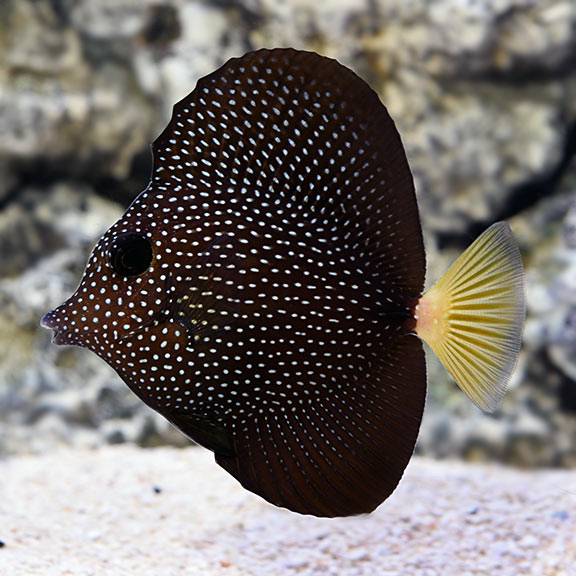
Locale: Madagascar
Madagascar Gemmatum Tang Zebrasoma gemmatum The Gemmatum Tang can be found in the Western Indian Ocean off the coast of Mozambique, South Africa, Madagascar and near the islands of Reunion and Mauritius. This spectacular Tang comes from deeper waters and surge zones which make collecting this fish challenging. One of the most prized specimens of all saltwater fish because of its striking color and contrast, it is also one of the most desirable Tangs for the reef aquarium. If housed properly, it is a rewarding and attractive addition to any large fish-only tank, or reef aquarium. They require good lighting, lots of free-swimming space and plenty of potential hiding spots. 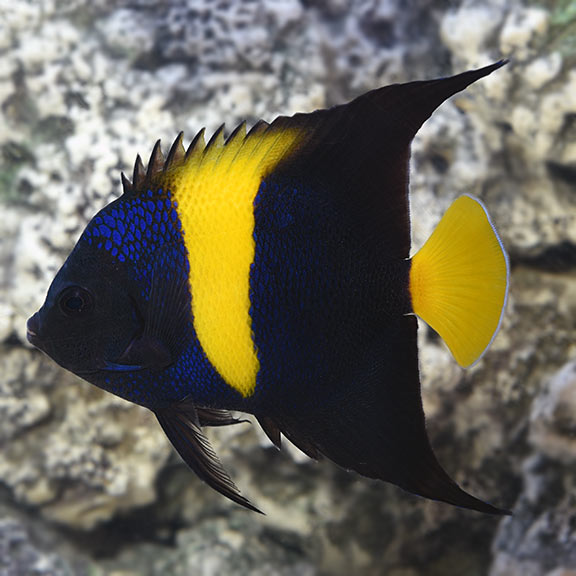
Locale: Red Sea
Asfur Angelfish Pomacanthus asfur The Asfur Angelfish originates in the Red Sea but is also found in the Indo-Pacific. As is the case with other Pomacanthus, the juvenile coloration is markedly different from the adult coloration. A shy fish that does best when not kept with other Asfurs due to territorial behavior, this Angelfish can grow to 16” in length and requires a minimum of a 150 gallon tank with numerous hiding places and live rock for grazing. Reef compatible with caution, it is prone to nip at stony and soft corals (sessile invertebrates) and clam mantles but may be kept with small polyped stony corals and somewhat noxious soft corals. 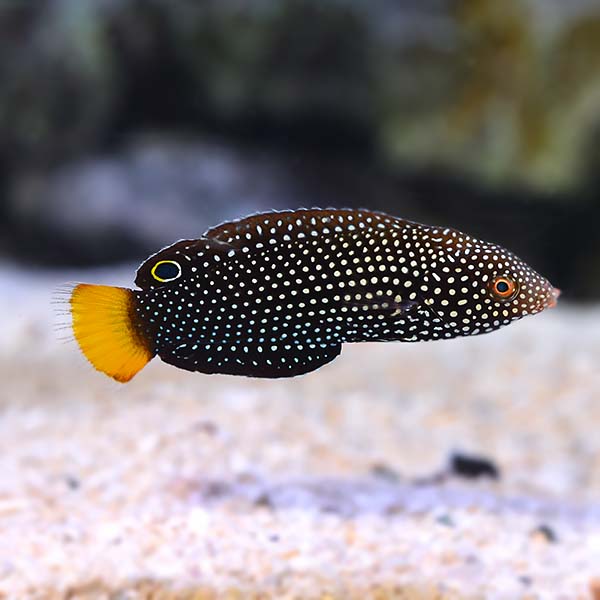
Locale: Red Sea
Yellowtail Wrasse EXPERT ONLY Anampses meleagrides The Yellowtail Wrasse is a reef fish that requires the care of an expert aquarist, as it may be very difficult to keep in an aquarium due to its feeding habits. When first introduced into the aquarium, live saltwater feeder shrimp should be used to entice this fish to eat. It eats very small invertebrates (amphiopods) that grow on live rock. This carnivore's diet should also include live, small feeder shrimps (brine, Mysis) and finely chopped marine meats. 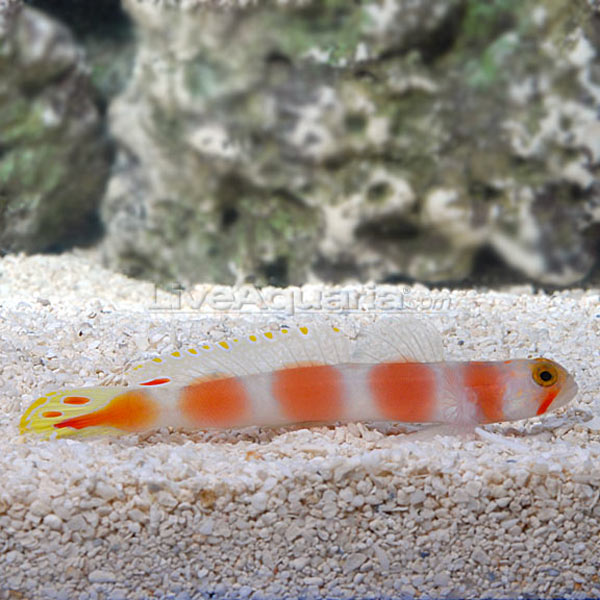
Locale: Africa
Pinkbar Goby Amblyeleotris aurora The Pinkbar Goby is also commonly referred to as the Shrimp Goby due to the close relationship that can form between it and various shrimp. It can grow to 4” in length and should be housed in a 10 gallon or larger aquarium with plenty of loose coral rubble and requires ample swimming room with a sand bottom for burrowing. It may try to jump out of the aquarium or other small opening, so a tight-fitting lid is required. Rarely will it become aggressive towards other fish but will fight with its own kind unless it is part of a mated pair. This carnivore has a care level that enables beginner aquarists to care for it. 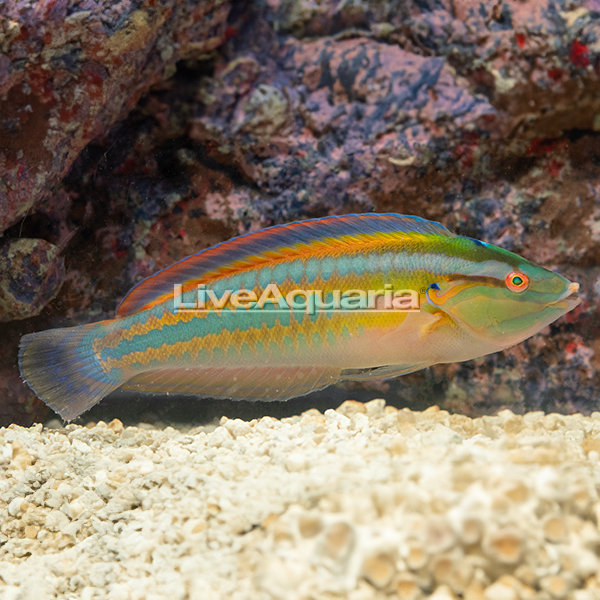
Locale: Africa
Rainbow Wrasse Coris atlantica The Rainbow Wrasse Coris atlantica can be found in nature on rocky shorelines among beds of grass or kelp. It can be kept alone, or in pairs if they are introduced into the aquarium at the same time. The aquascaping should be changed so there are no established territories when new fish are added. Because the Coris atlantica is born female but has the ability to become male later in life, it has an interesting color story. Juveniles present themselves with a white body and orange horizontal stripes (the white areas contain a hint of the coloration that is needed if it becomes male later in life). When the juvenile reaches adulthood, females will keep their juvenile coloration. Those that become male will present a dynamic palette of blue and green stripes and an orange eye. Males are generally larger than the females. 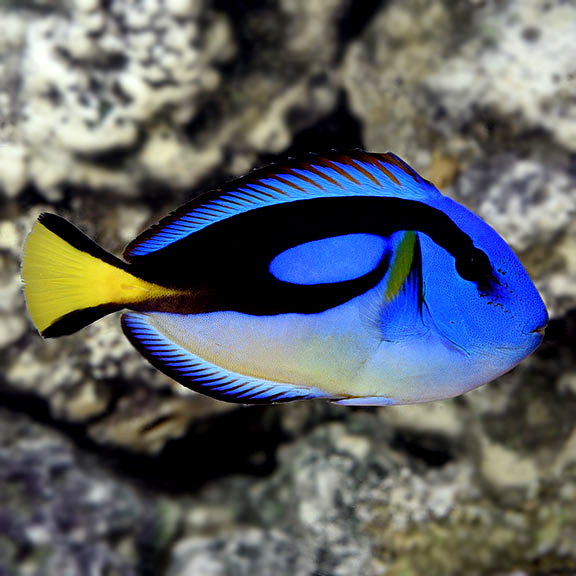
Locale: Kenya
Yellow Belly Regal Blue Tang Paracanthurus hepatus var. The Yellow Belly Regal Blue Tang is a gorgeous color variety of the popular Blue Tang. In addition to having the showy coloration of a Blue Tang, this variety has a brilliant yellow coloration that covers a greater portion of the body. The yellow coloration, most prominent on the caudal fin, continues across the belly region, giving the Yellow Belly Regal Blue Tang an exciting boost in color. Small Yellow Belly Regal Blue Tangs will not exhibit the yellow belly coloration until they mature. Although Tangs will eat foods along with the other fish in the aquarium, it is important that they are offered plenty of marine-based algae or seaweed, which boots their immune system, reduces aggression, and improves their overall health. Reef compatible, they can grow to 12” in length and require an aquarium that has a capacity of 180 gallons or more. 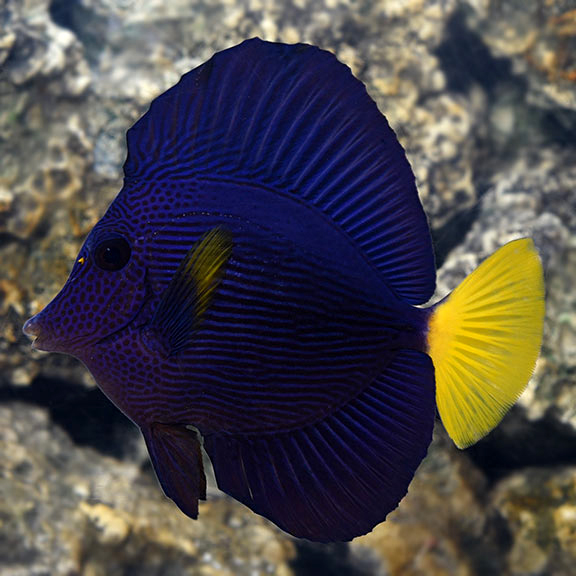
Locale: Kenya
Purple Tang Zebrasoma xanthurum The Purple Tang is one of the most prized specimens of all saltwater fish for its coloration, and one of the most popular Tangs for the reef aquarium. It is blue to purple in color and can reach a size of 10 inches. Semi-aggressive, it is best cared for by an aquarist who has some experience. Although Tangs will eat foods along with the other fish in the aquarium, it is important that they are offered plenty of marine-based algae or seaweed, which boots their immune system, reduces aggression, and improves their overall health. African aquarium fish
In efforts to protect the biodiversity of aquatic life, African conservation efforts are being implemented to protect certain areas, enforce regulations, and provide education. These efforts should help protect African aquatic life and allow aquarists the opportunity to enjoy their beauty and diversity for years to come. |
|
|




